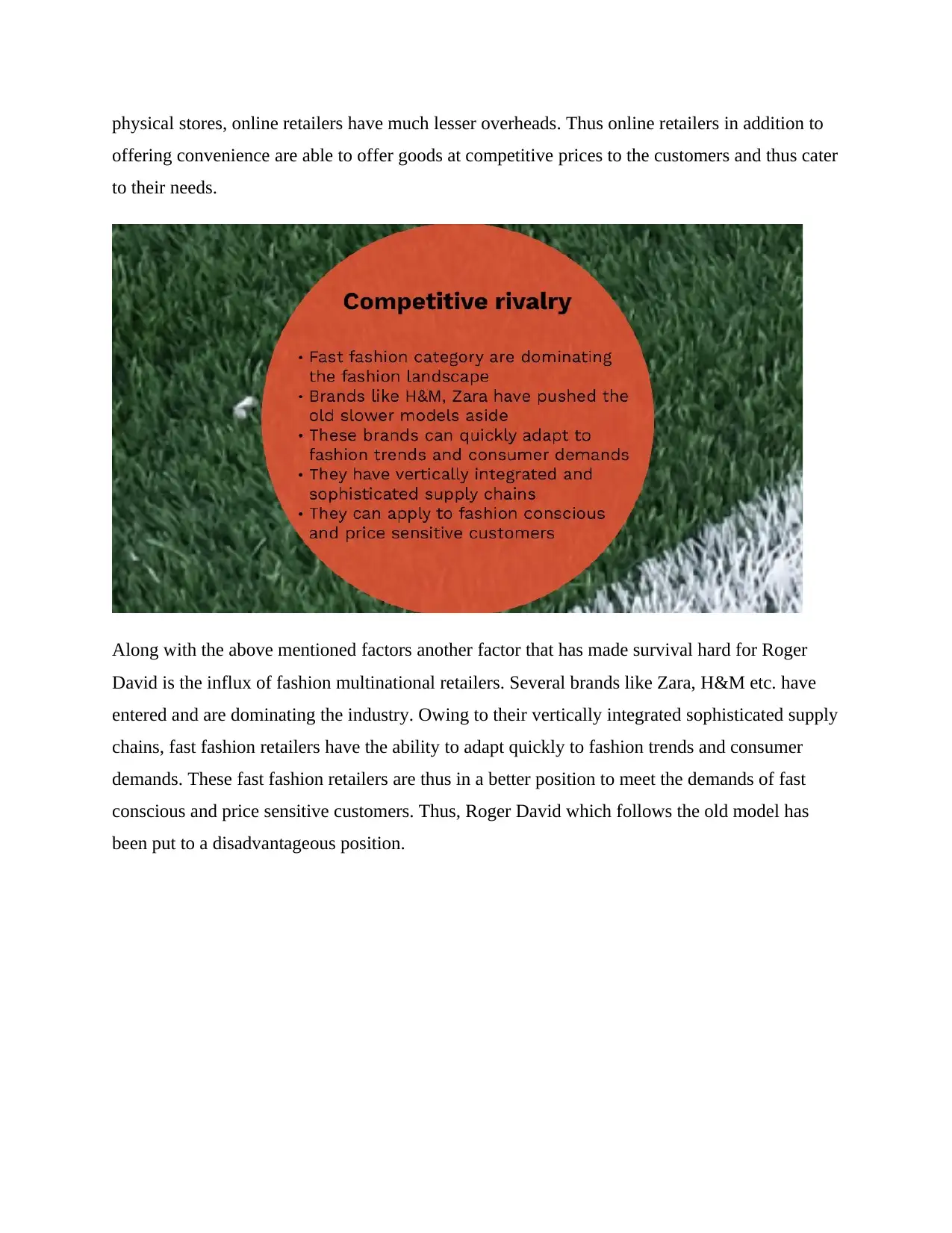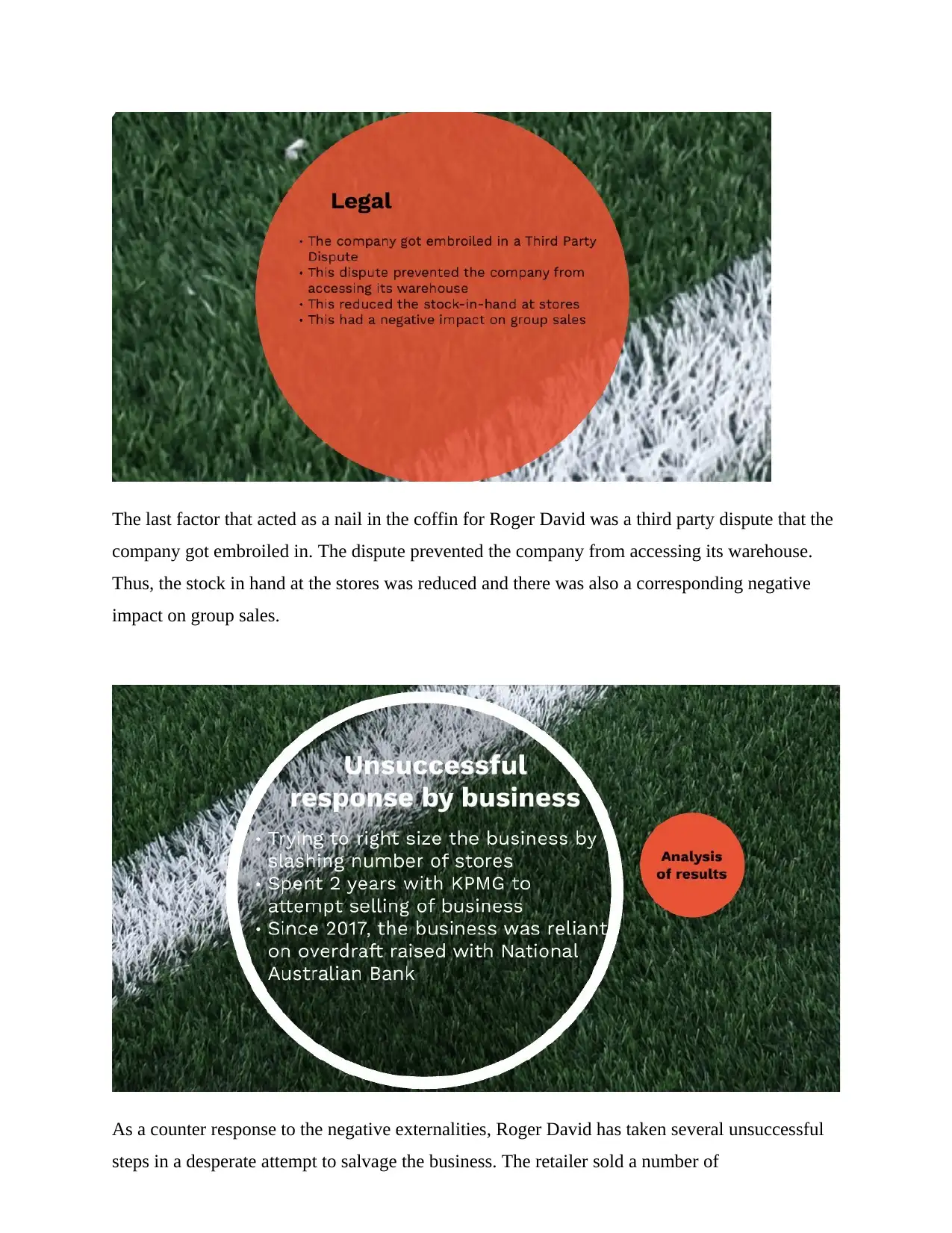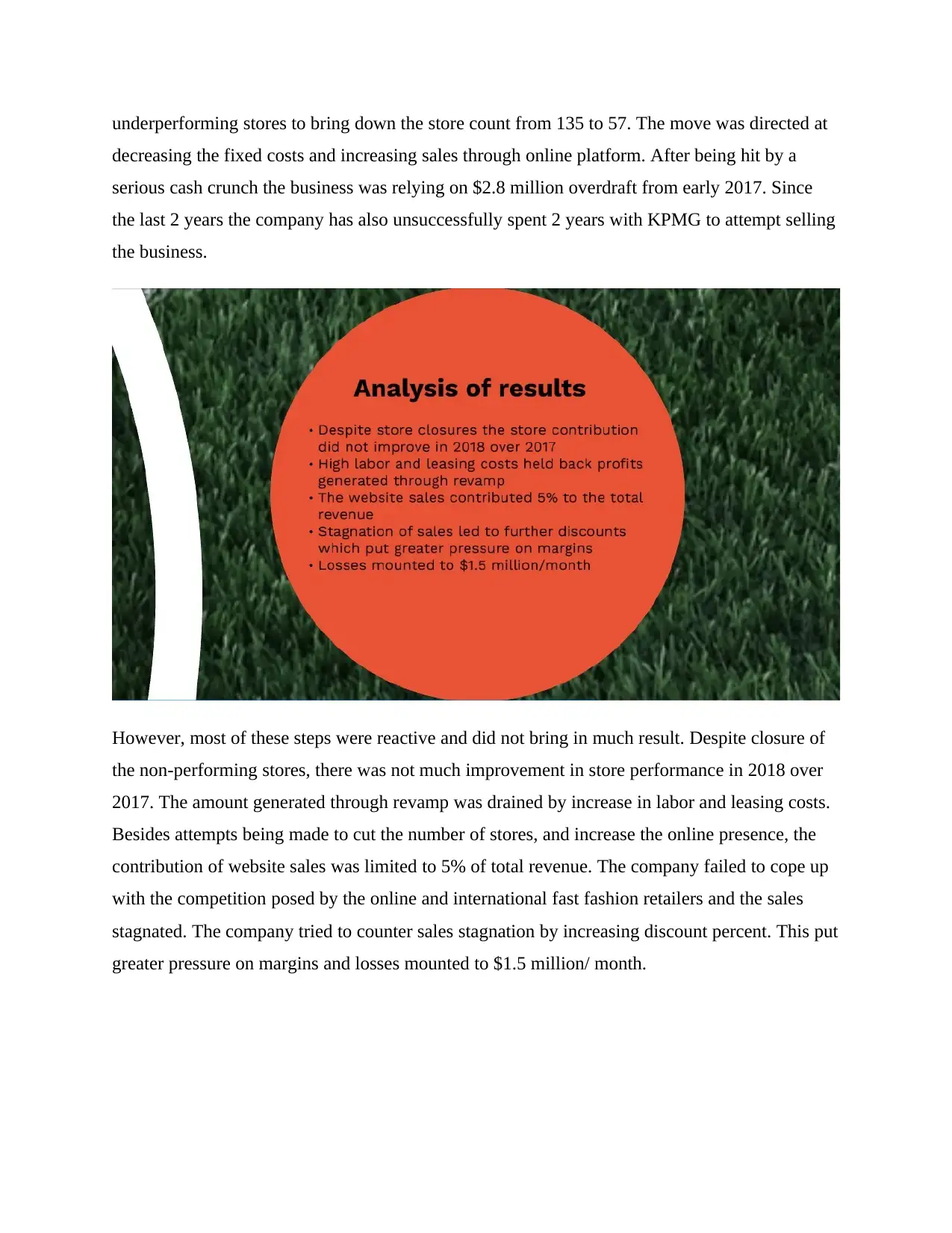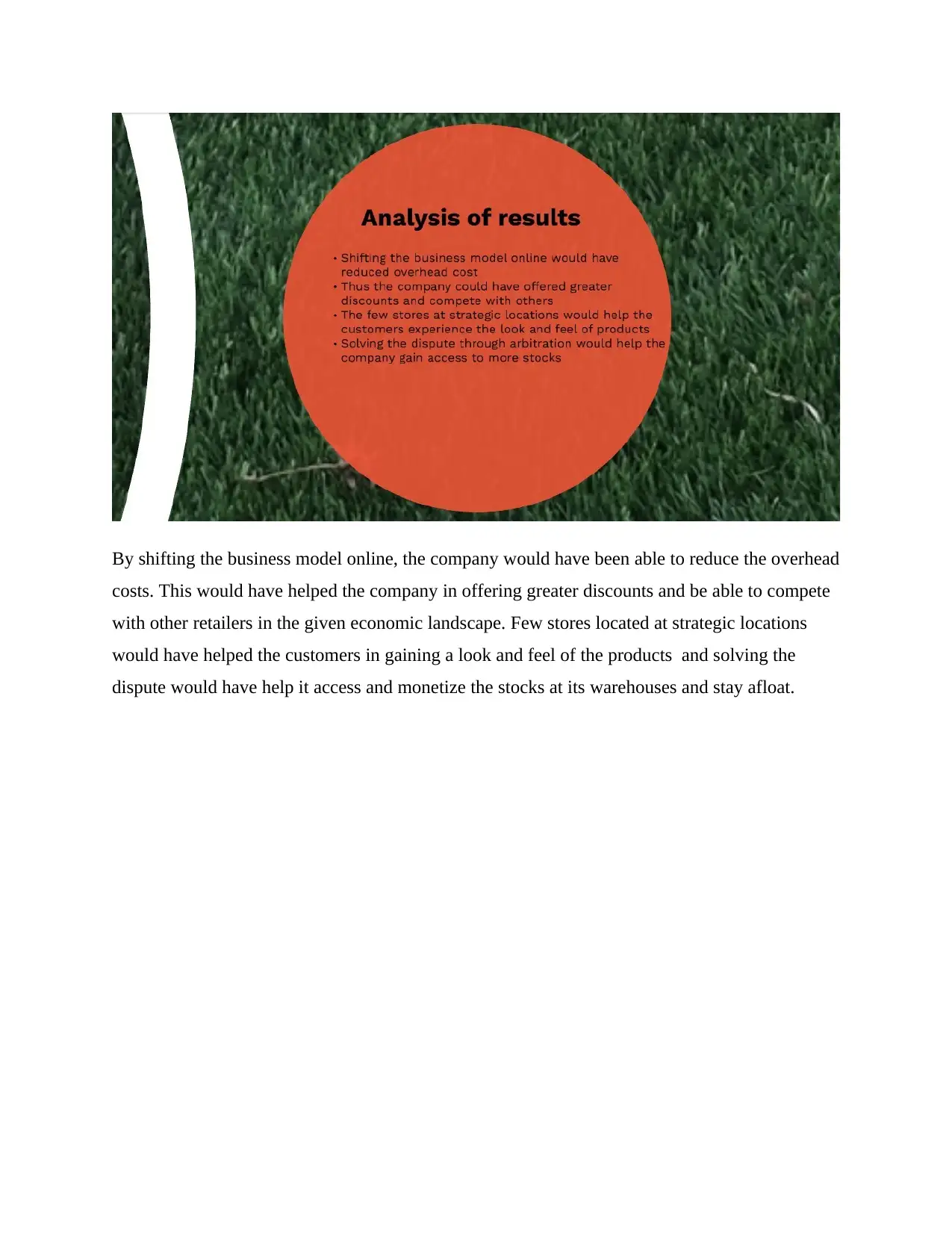BIZ202 Module 6: Analysis of Roger David's Bankruptcy Factors
VerifiedAdded on 2023/01/16
|8
|1081
|77
Presentation
AI Summary
This presentation analyzes the bankruptcy of Roger David, a men's fashion retailer that filed for bankruptcy in 2018. It examines the impact of the external business environment, including weak customer confidence due to the Australian economy, increased competition from online retailers like Amazon and fast fashion brands such as Zara and H&M, and a third-party dispute that restricted access to its warehouse. The presentation highlights the company's unsuccessful attempts to prevent bankruptcy, such as closing stores and seeking overdrafts, and recommends strategies that could have been more effective, such as focusing on online sales, strategically locating retail stores, and resolving the third-party dispute. The analysis emphasizes the importance of understanding market trends and adapting to changes in the external environment to ensure business survival.

The presentation has been done on prezi and can be accessed through the link given below
https://prezi.com/p/dafjfqx51itn/business-environemnt/#present
Here are notes or the transcript
Good morning! I am (write your name) and today my topic of discussion will be the impact of
external business environment on a company. With reference to a particular company which has
filed for bankruptcy in recent times, I will analyze the reasons behind the failure. In particular, I
would analyze the unsuccessful steps that were taken by the company to prevent bankruptcy and
recommend steps that should have been taken.
https://prezi.com/p/dafjfqx51itn/business-environemnt/#present
Here are notes or the transcript
Good morning! I am (write your name) and today my topic of discussion will be the impact of
external business environment on a company. With reference to a particular company which has
filed for bankruptcy in recent times, I will analyze the reasons behind the failure. In particular, I
would analyze the unsuccessful steps that were taken by the company to prevent bankruptcy and
recommend steps that should have been taken.
Paraphrase This Document
Need a fresh take? Get an instant paraphrase of this document with our AI Paraphraser

The company that has been chosen for analysis is Roger David. Roger David has filed for
bankruptcy in 2018. However, the company has a rich history and had been selling suits and
other items of men’s fashion since 1942. At one point of time the company selling brands like
RDX and Roger had 100 operational stores under its banner. However, Roger David could not
cope up with rapid changes in the external environment and therefore filed for bankruptcy.
bankruptcy in 2018. However, the company has a rich history and had been selling suits and
other items of men’s fashion since 1942. At one point of time the company selling brands like
RDX and Roger had 100 operational stores under its banner. However, Roger David could not
cope up with rapid changes in the external environment and therefore filed for bankruptcy.

In the external environment there are several factors that have acted against Roger David. For
instance one of the primary factors that have negatively affected all the retailers is a weak
customer confidence. This has led to stagnancy of sales. There has also been an increase in
competition owing to the influx of Amazon and other overseas retailers. These factors have
together led to a tough retail landscape where Roger David could not survive.
As stated in the last slide, the Australian economy is suffering from poor customer confidence.
The reason for this lies in the current economic landscape of the country. Australia, has
witnessed an absence in the growth of real wages. However, the cost of basic expenses has
continued its northwards march. Thus the discretionary spending of the consumers has taken a
hit. The retailers are thus being forced to compete against each other in terms of price so as to
continue attracting customers. However, the continuous upward march of the fixed costs
associated with brick and mortar stores means that retailers like Roger David have to either lose
sales or sale at a price that is lower than costs.
Along with the crippling impact of the economy another factor that has made survival hard for
Roger David is the influx of online retailers like Amazon. As compared to the retailers with
instance one of the primary factors that have negatively affected all the retailers is a weak
customer confidence. This has led to stagnancy of sales. There has also been an increase in
competition owing to the influx of Amazon and other overseas retailers. These factors have
together led to a tough retail landscape where Roger David could not survive.
As stated in the last slide, the Australian economy is suffering from poor customer confidence.
The reason for this lies in the current economic landscape of the country. Australia, has
witnessed an absence in the growth of real wages. However, the cost of basic expenses has
continued its northwards march. Thus the discretionary spending of the consumers has taken a
hit. The retailers are thus being forced to compete against each other in terms of price so as to
continue attracting customers. However, the continuous upward march of the fixed costs
associated with brick and mortar stores means that retailers like Roger David have to either lose
sales or sale at a price that is lower than costs.
Along with the crippling impact of the economy another factor that has made survival hard for
Roger David is the influx of online retailers like Amazon. As compared to the retailers with
⊘ This is a preview!⊘
Do you want full access?
Subscribe today to unlock all pages.

Trusted by 1+ million students worldwide

physical stores, online retailers have much lesser overheads. Thus online retailers in addition to
offering convenience are able to offer goods at competitive prices to the customers and thus cater
to their needs.
Along with the above mentioned factors another factor that has made survival hard for Roger
David is the influx of fashion multinational retailers. Several brands like Zara, H&M etc. have
entered and are dominating the industry. Owing to their vertically integrated sophisticated supply
chains, fast fashion retailers have the ability to adapt quickly to fashion trends and consumer
demands. These fast fashion retailers are thus in a better position to meet the demands of fast
conscious and price sensitive customers. Thus, Roger David which follows the old model has
been put to a disadvantageous position.
offering convenience are able to offer goods at competitive prices to the customers and thus cater
to their needs.
Along with the above mentioned factors another factor that has made survival hard for Roger
David is the influx of fashion multinational retailers. Several brands like Zara, H&M etc. have
entered and are dominating the industry. Owing to their vertically integrated sophisticated supply
chains, fast fashion retailers have the ability to adapt quickly to fashion trends and consumer
demands. These fast fashion retailers are thus in a better position to meet the demands of fast
conscious and price sensitive customers. Thus, Roger David which follows the old model has
been put to a disadvantageous position.
Paraphrase This Document
Need a fresh take? Get an instant paraphrase of this document with our AI Paraphraser

The last factor that acted as a nail in the coffin for Roger David was a third party dispute that the
company got embroiled in. The dispute prevented the company from accessing its warehouse.
Thus, the stock in hand at the stores was reduced and there was also a corresponding negative
impact on group sales.
As a counter response to the negative externalities, Roger David has taken several unsuccessful
steps in a desperate attempt to salvage the business. The retailer sold a number of
company got embroiled in. The dispute prevented the company from accessing its warehouse.
Thus, the stock in hand at the stores was reduced and there was also a corresponding negative
impact on group sales.
As a counter response to the negative externalities, Roger David has taken several unsuccessful
steps in a desperate attempt to salvage the business. The retailer sold a number of

underperforming stores to bring down the store count from 135 to 57. The move was directed at
decreasing the fixed costs and increasing sales through online platform. After being hit by a
serious cash crunch the business was relying on $2.8 million overdraft from early 2017. Since
the last 2 years the company has also unsuccessfully spent 2 years with KPMG to attempt selling
the business.
However, most of these steps were reactive and did not bring in much result. Despite closure of
the non-performing stores, there was not much improvement in store performance in 2018 over
2017. The amount generated through revamp was drained by increase in labor and leasing costs.
Besides attempts being made to cut the number of stores, and increase the online presence, the
contribution of website sales was limited to 5% of total revenue. The company failed to cope up
with the competition posed by the online and international fast fashion retailers and the sales
stagnated. The company tried to counter sales stagnation by increasing discount percent. This put
greater pressure on margins and losses mounted to $1.5 million/ month.
decreasing the fixed costs and increasing sales through online platform. After being hit by a
serious cash crunch the business was relying on $2.8 million overdraft from early 2017. Since
the last 2 years the company has also unsuccessfully spent 2 years with KPMG to attempt selling
the business.
However, most of these steps were reactive and did not bring in much result. Despite closure of
the non-performing stores, there was not much improvement in store performance in 2018 over
2017. The amount generated through revamp was drained by increase in labor and leasing costs.
Besides attempts being made to cut the number of stores, and increase the online presence, the
contribution of website sales was limited to 5% of total revenue. The company failed to cope up
with the competition posed by the online and international fast fashion retailers and the sales
stagnated. The company tried to counter sales stagnation by increasing discount percent. This put
greater pressure on margins and losses mounted to $1.5 million/ month.
⊘ This is a preview!⊘
Do you want full access?
Subscribe today to unlock all pages.

Trusted by 1+ million students worldwide

The ideal response for the retailer would have been to understand the polarization trends in the
market in advance and accordingly right size the store network at the right time. Failing to do so
left it susceptible to rising rental costs. Instead of having too many retail stores the company
should have strived to drive most of the sales through online medium and lower the overheads.
Instead of so many retail stores, there should have been few retail stores located at strategic
locations to complement the online presence. The company should have also made it a priority to
settle the dispute with the third party on a trial basis through arbitration which would have let it
access the warehouses and monetize its stocks.
market in advance and accordingly right size the store network at the right time. Failing to do so
left it susceptible to rising rental costs. Instead of having too many retail stores the company
should have strived to drive most of the sales through online medium and lower the overheads.
Instead of so many retail stores, there should have been few retail stores located at strategic
locations to complement the online presence. The company should have also made it a priority to
settle the dispute with the third party on a trial basis through arbitration which would have let it
access the warehouses and monetize its stocks.
Paraphrase This Document
Need a fresh take? Get an instant paraphrase of this document with our AI Paraphraser

By shifting the business model online, the company would have been able to reduce the overhead
costs. This would have helped the company in offering greater discounts and be able to compete
with other retailers in the given economic landscape. Few stores located at strategic locations
would have helped the customers in gaining a look and feel of the products and solving the
dispute would have help it access and monetize the stocks at its warehouses and stay afloat.
costs. This would have helped the company in offering greater discounts and be able to compete
with other retailers in the given economic landscape. Few stores located at strategic locations
would have helped the customers in gaining a look and feel of the products and solving the
dispute would have help it access and monetize the stocks at its warehouses and stay afloat.
1 out of 8
Related Documents
Your All-in-One AI-Powered Toolkit for Academic Success.
+13062052269
info@desklib.com
Available 24*7 on WhatsApp / Email
![[object Object]](/_next/static/media/star-bottom.7253800d.svg)
Unlock your academic potential
Copyright © 2020–2025 A2Z Services. All Rights Reserved. Developed and managed by ZUCOL.





